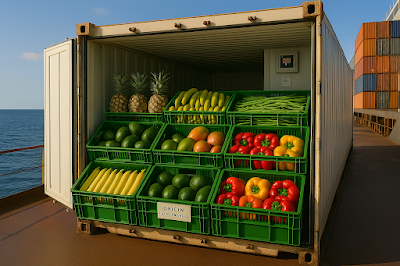Due to the limited shelf life, a shipper should be aware of common mistakes when importing perishables. Perishable cargo refers to any item that can spoil, deteriorate, or lose quality if not shipped under proper conditions. Some examples include fresh produce, such as fruits and vegetables, meat, dairy products, bakery items, and frozen items. Along with foods, it can also include pharmaceuticals, chemicals, cosmetics, and flowers. Due to the cargo type, they must be stored, handled, and transported with temperature and time sensitivity in mind. Along with importing, this can also include domestic shipping. This article will explain the top mistakes shippers face when importing perishables and how to prevent them from occurring.
What Are Common Mistakes Made By Shippers That Import Perishables?
As previously mentioned, the shipper must handle perishables properly throughout the entire shipping process. One of the biggest mistakes importers make is not having proper cold chain management. From the start of the journey to the final delivery, it is crucial that the cargo remains at a continuous, suitable temperature. Even brief periods away from the optimal temperature can result in spoilage or contamination. Spoilage can be particularly detrimental if the importer is a business with a large customer base. Not only can it lead to monetary loss, but it also looks bad on the importer. Another common mistake shippers face when importing perishables is failing to understand its time-sensitive nature.
Perishables are goods that have a limited and specified shelf life, depending on the item. After the date passes, they become unsuitable for consumption or use. Importers tend to underestimate transit time by choosing cheaper routes, which can extend the importation time. The extension can come from port congestion, leading to delays. In turn, the delays can reduce the shelf life and make the product unusable. Another common mistake shippers can face when importing perishables is having incorrect documentation. Due to the nature of this cargo type, specific documents may be required, such as import permits, health certificates, and FDA prior notices. Failure to provide them can result in fines, customs delays, and even the confiscation of the shipment.
How To Prevent These Mistakes When Importing Perishables?
With the various ways that mistakes can negatively impact perishable imports, there are methods to prevent them from occurring. To ensure proper temperature control throughout the journey, the shipper should use trusted carriers that specialize in this cargo type. Using reefer containers with temperature monitoring devices is also essential in preventing spoilage. Shippers must also be aware of the shelf life of their cargo and plan their supply chains accordingly. The importation routes should be speedy, reliable, and factor in wait time for customs clearance. Along with understanding the regulations and paperwork for importing specific perishable the shipper munt ensure that the packaging is correct.
When importing perishables into the US, shippers must understand what can go wrong to mitigate potential problems. Failing to prepare correctly can lead to significant disruptions in the supply chain. Another way to avoid making mistakes when importing perishables is to consult a customs broker. Brokers act as intermediaries between the importer and the customs of the country to which they are importing. In the US, it’s CBP (Customs and Border Protection), and brokers help with clearing goods from customs. They achieve this by offering solutions such as filing entries, calculating duties, and providing paperwork, among others. Contact A1 Worldwide Logistics at 305-425-9752 or info@a1wwl.com to speak with a broker about the success of your shipment.
